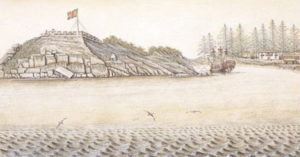I have always been fascinated by British Columbia’s west coast history and I see that Canada’s 150 Anniversary has brought

attention to first contact between Europeans and Indigenous people on this coast. As far as is known, first contact took place at Nootka Sound in 1774 between the Spanish and the Mowachaht people, although it is believed that Sir Francis Drake visited these shores in the 1500s.
I presented a talk on the Nootka Crisis this spring at the Museum at Campbell River, then again at the Courtenay Museum on Wednesday, May 10. As this talk was sold out I will be returning again in October to repeat it. On Saturday, May 13 at 7:00pm I presented the talk on Cortes Island at Mansons Hall and will be returning there in October to talk about Yorke Island. In September I will give the talk in Tahsis, and this summer at other locations – times and dates not yet confirmed.
An excellent book I read about European visitors to Nootka Sound, First Invaders by Alan Twigg is an excellent resource about this history. It answered some of my questions, but raised some as well. I didn’t fully understand why the Spanish didn’t stay in this part of the world once they had a foothold. Through my studies at the University of Victoria, where I am currently pursuing my Masters in History (got through the first year, yeah!) I had an opportunity to really delve into the research of who got to Nootka Sound first and what they were doing, and as it turned out, not doing there. I wrote a paper entitled Nootka Unsettled where I discuss the various writings about an event known as the Nootka Crisis or Controversy that took place in 1789. I was pleased to find William Manning’s book written in 1904, The Nootka Sound Controversy, that was likely the first scholarly investigation into the Crisis. The Crisis or Controversy was a standoff between the Spanish and British about who in fact, had the right to occupy Yuquot (Friendly Cove) on Nootka Island. This of course, was irrespective of the fact that the Mowachaht had been occupying the region for over 4,000 years!
Spanish exploration into the Pacific Northwest began in earnest in the 1770s, with the Spanish sending ships on surveying expeditions out of San Blas, Mexico their Pacific port. The first known visitor to the Nootka region was the chief naval officer at San Blas, Captain Juan Pérez, sailing in the Santiago. He didn’t set foot on Nootka Island, but did meet the native inhabitants. Captain James Cook was to discover that some of the people he encountered four years later in 1778 wore silver spoons, that would have come from the Spanish. The Crisis is a complicated story that arose several years later. It is a matter of claim and counter-claim, with the Spaniard Esteban Jose Martinez asserting that the Spanish were the first to occupy Yuquot with their fort San Miguel, and the British represented by trader James Colnett wondering what happened to the buildings erected by his partner, John Meares the year before. The two governments battled it out in a document known as the Nootka Convention, which drew of the history of exploration to the area.
Ultimately, Captain George Vancouver would be tasked with trying to bring resolution to the occupation in 1792, when he visited Nootka Sound to discuss the matter with Juan Fransisco de la Bodega y Quadra. Neither Captain felt they could resolve the issue and left it to their respective governments. The interesting thing is, that in the end, both countries decided not to stay there and the Mowachaht happily took back the property where the Spanish fort had been erected once the Spanish left.
My presentation is pictorial, and I discuss the ins and outs of European notions of occupation in detail. The Crisis was a drama played out at a location remote from any European government, that almost resulted in war. Perhaps because Quadra and Vancouver were excessively polite with each other and like each other, war was averted. Who knows what might have happened if either man became heavy-handed about the issue? And, as I was asked at recent presentation, what would have happened if the Spanish did not desert Friendly Cove? Yo me pregunto!
